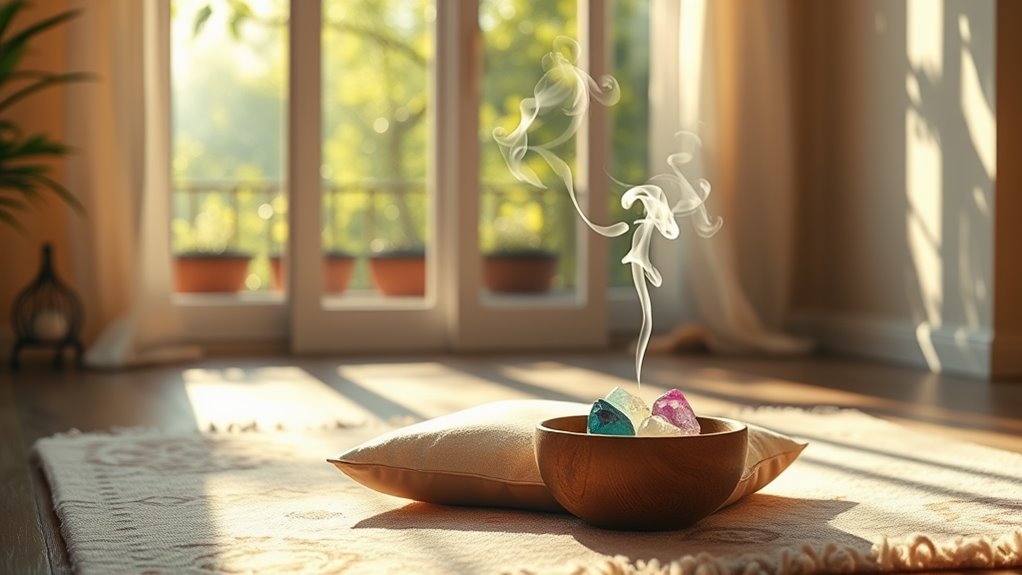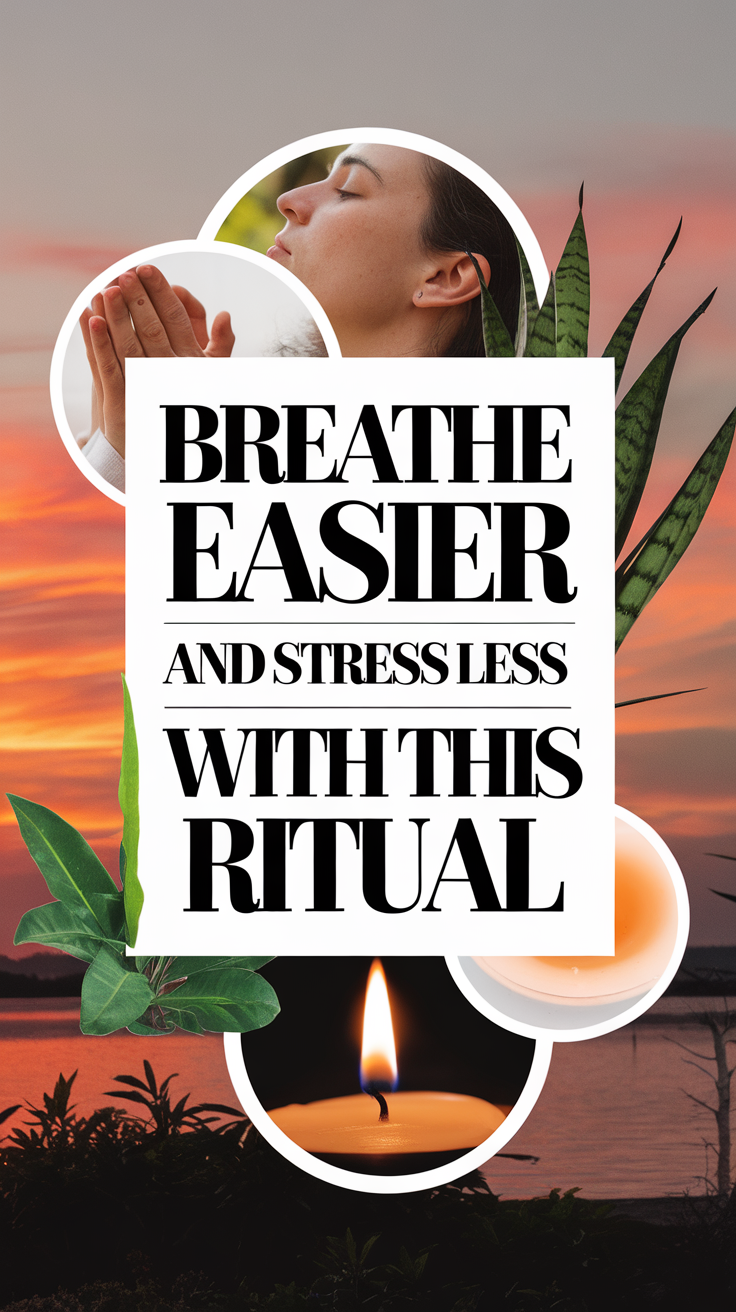Breathe Easier and Stress Less With This Ritual
To breathe easier and stress less, start by creating a calming space. Clear clutter, add soothing scents, and play soft music. Practice the 4-7-8 breathing technique: inhale through your nose for four counts, hold for seven, and exhale through your mouth for six. Incorporate gentle movements like stretching or yoga to enhance relaxation. Track your progress and feelings to see how your mood evolves. There’s so much more to explore in crafting your personalized stress-relief ritual.
Key Takeaways
- Practice the 4-7-8 breathing technique to activate relaxation and reduce anxiety in just one minute.
- Create a calming environment by decluttering and using soothing aromas like lavender or citrus.
- Incorporate visualization techniques by imagining peaceful scenes to lower heart rate and ease tension.
- Establish a daily breathing routine and track your progress to stay consistent and motivated.
- Pair deep breathing with gentle movements or stretches for enhanced relaxation and well-being.
Understanding the Connection Between Breath and Stress
When you feel overwhelmed by stress, it’s easy to overlook the simple act of breathing, yet it plays an essential role in how your body responds to tension.
Your breath is a powerful tool for natural anxiety relief. When you focus on your breathing, you activate your body’s relaxation response, helping to calm racing thoughts and lower your heart rate. Practicing the 4-7-8 breathing technique can enhance this calming effect even further.
By taking slow, deep breaths, you signal to your nervous system that it’s time to relax. This shift can diminish feelings of anxiety and stress, making it easier for you to regain control. Engaging in deep breathing exercises has been shown to significantly reduce anxiety symptoms in just a minute.
The Science Behind Mindful Breathing
Although many people underestimate its impact, mindful breathing is backed by solid science that highlights its benefits for mental and physical health.
Research shows that focusing on your breath can activate the parasympathetic nervous system, which promotes relaxation and reduces stress. This practice helps lower cortisol levels, stabilizing your mood and enhancing emotional resilience. Additionally, employing techniques such as the 4-7-8 breathing technique can significantly enhance the calming effects of mindful breathing.
When you breathe mindfully, you increase oxygen flow to your brain, boosting concentration and clarity. It also encourages you to stay present, reducing anxiety about the future or regrets about the past. Furthermore, deep breathing techniques have been shown to be an immediate anxiety relief method, providing effective support for those experiencing heightened stress levels.
Preparing Your Space for Relaxation
Creating a relaxing space starts with decluttering to clear your mind and promote clarity. Incorporating soothing aromas and sounds can elevate your environment, making it more inviting. Additionally, the use of breath control techniques can foster a deeper sense of relaxation and calm. Finally, guarantee you have a comfortable seating arrangement that encourages you to unwind and truly relax. Additionally, consider practicing the 4-7-8 breathing technique as it can significantly enhance your ability to achieve restful sleep in this tranquil setting.
Declutter for Clarity
To truly unwind and embrace relaxation, you need a space that promotes clarity and calmness. Start by evaluating your environment—what’s cluttering your mind? Remove items that don’t serve a purpose or bring you joy. This could mean tossing old magazines, organizing your desk, or simply rearranging furniture for better flow.
Consider creating designated areas for different activities; a cozy corner for reading or a serene spot for meditation can make a world of difference.
As you declutter, you’ll find that each item you let go of lightens your mental load. Remember, a clear space leads to a clear mind, so take a moment to breathe deeply and enjoy the serenity of your newly organized surroundings.
Soothing Aromas and Sounds
As you prepare your space for relaxation, incorporating soothing aromas and calming sounds can greatly enhance your experience.
Begin by selecting essential oils like lavender or chamomile, known for their relaxing properties. A diffuser can disperse these delightful scents, creating an inviting atmosphere. If you prefer candles, choose those made from natural wax with essential oils for a gentle, aromatic glow.
Next, consider the sounds that surround you. Soft, ambient music or nature sounds, like gentle rain or ocean waves, can help quiet your mind.
You might even explore guided meditations or calming soundscapes. By thoughtfully combining these sensory elements, you’ll create a sanctuary that encourages tranquility and peace, making your relaxation ritual even more fulfilling.
Comfortable Seating Arrangement
While you may overlook the importance of a comfortable seating arrangement, it plays a crucial role in your relaxation experience. A well-chosen spot can transform your space into a sanctuary.
Here are three key elements to take into account:
-
Cushioning: Opt for soft, supportive cushions. They’ll help you sink in and let go of tension.
-
Posture: Select seating that encourages good posture. Maintaining alignment reduces strain and enhances comfort.
-
Ambiance: Position your seating to take advantage of natural light and calming views. A soothing environment fosters a sense of peace.
Techniques for Effective Deep Breathing
Deep breathing can transform your mental state and overall well-being, especially when you feel overwhelmed.
To start, find a comfortable position and close your eyes. Inhale deeply through your nose for a count of four, allowing your abdomen to expand. Hold that breath for a moment, then exhale slowly through your mouth for a count of six.
Focus on the rhythm of your breath, letting go of tension with each exhale. You can also try the 4-7-8 technique: inhale for four seconds, hold for seven, and exhale for eight.
Repeat this cycle several times. Incorporating these techniques into your daily routine can help you manage stress and cultivate a sense of calm whenever you need it.
Incorporating Aromatherapy Into Your Ritual
Incorporating aromatherapy into your relaxation routine can enhance your experience and promote a sense of calm.
You’ll want to choose essential oils that resonate with you, whether it’s lavender for relaxation or citrus for energy.
Plus, using effective diffusion techniques can create a serene environment that supports your journey to breathe easier and stress less.
Essential Oils Selection
Choosing the right essential oils can transform your daily rituals into powerful moments of relaxation and rejuvenation.
With so many options available, it’s crucial to select oils that resonate with your needs. Here are three popular choices to reflect upon:
-
Lavender: Known for its calming properties, lavender can help ease anxiety and promote better sleep.
-
Peppermint: This invigorating oil can uplift your mood and boost mental clarity, making it perfect for daytime use.
-
Bergamot: With its citrusy aroma, bergamot is excellent for reducing stress and enhancing feelings of joy.
Experiment with these oils to find which ones blend harmoniously with your rituals.
Diffusion Techniques Explained
Aromatherapy can elevate your daily rituals, creating an environment that promotes relaxation and well-being.
One effective way to incorporate essential oils is through diffusion. You’ve got options here: an electric diffuser, a candle diffuser, or even a simple bowl of hot water.
With an electric diffuser, just add water and a few drops of your chosen oil, turning it on to disperse the aroma throughout your space. For a candle diffuser, place a tea light underneath the oil bowl—watch the heat gently release the scent.
If you’re in a pinch, add oils to hot water, letting the steam carry the fragrance. Experiment with different techniques to discover which best suits your needs and enhances your ritual.
Creating a Calm Space
How can you transform your space into a sanctuary of calm? Incorporating aromatherapy is a fantastic way to create that soothing atmosphere.
Here are three steps to get you started:
-
Choose Your Scents: Select essential oils that resonate with you, like lavender for relaxation or citrus for energy.
-
Set the Mood: Dim the lights, play soft music, and declutter your space. A clean environment promotes peace.
-
Use a Diffuser: Invest in a good diffuser and let the aromatic oils gently fill your room, enhancing your relaxation ritual.
The Role of Visualization in Stress Relief
Have you ever noticed how a simple mental image can shift your mood and ease your tension? Visualization is a powerful tool for stress relief, allowing you to escape from the chaos of the moment.
When you create vivid mental scenes—like a serene beach or a peaceful forest—you engage your senses, making your mind believe it’s truly there. This practice can lower your heart rate and reduce anxiety, helping you feel more grounded.
Plus, it’s an easy technique you can use anywhere, anytime. Just close your eyes, take a deep breath, and let your imagination guide you.
Creating a Consistent Daily Practice
To truly reap the benefits of stress relief, establishing a consistent daily practice is essential.
You can start by setting a specific time that works for you, choosing an environment that feels calming, and incorporating mindful breathing techniques. Incorporating breathing exercises into your routine can significantly enhance your energy levels and overall well-being. Additionally, practicing pressure point techniques can provide immediate relief from nasal congestion, making it easier to breathe during your routine.
These simple steps can transform your routine and help you breathe easier throughout your day.
Set a Specific Time
Establishing a specific time each day for your breathing practice can transform it from a fleeting thought into a cherished ritual.
When you carve out this time, you create space for mindfulness and stress relief.
Here are three tips to help you set a consistent schedule:
-
Choose a time that fits your routine: Whether it’s first thing in the morning, during lunch, or before bed, pick a time that feels natural for you.
-
Set reminders: Use your phone or calendar to prompt you, ensuring you don’t forget your important practice.
-
Be flexible: Life happens, and that’s okay! If you miss a session, don’t be hard on yourself; just return to your routine the next day.
Consistency is key to reaping the benefits.
Choose Your Environment
Choosing the right environment for your breathing practice is essential, as it can greatly enhance your experience and commitment.
Look for a quiet, comfortable space where you won’t be disturbed. Natural light or calming colors can help create a peaceful atmosphere. Whether it’s a cozy corner of your home, a serene park, or even a favorite room, make it a place you associate with relaxation and focus.
Adding personal touches, like a calming scent or soft music, can further enrich your practice.
Incorporate Mindful Breathing
While it may seem challenging to incorporate mindful breathing into your daily routine, it’s easier than you think once you find a rhythm that works for you.
Start by setting aside just a few minutes each day. Here are three steps to guide you:
-
Choose a Time: Pick a consistent time, like morning or before bed, to make it a habit.
-
Find Your Spot: Select a comfortable, quiet place to focus without distractions.
-
Practice Deep Breathing: Inhale deeply through your nose, hold for a few seconds, and exhale slowly through your mouth.
Enhancing Your Ritual With Gentle Movement
Incorporating gentle movement into your daily rituals can transform the way you connect with your body and mind. Whether it’s a few stretches, yoga poses, or a slow walk, these movements help you release tension and enhance your overall well-being. Adding calming herbs such as chamomile or lavender to your routine can further promote relaxation and improve sleep quality.
As you engage in this practice, focus on how your body feels, allowing yourself to be present in the moment. You don’t need to perform complicated routines; simple, fluid motions are enough to create a sense of calm.
Pair these movements with your mindful breathing to deepen the experience, fostering a harmonious connection between body and breath. Embrace this gentle movement as a nurturing way to center yourself, reduce stress, and cultivate a more mindful day. Additionally, integrating mindfulness techniques into your routine can significantly improve your sleep quality.
Tracking Your Progress and Feelings
As you commence on your journey of self-care, tracking your progress and feelings can be a powerful way to stay connected to your growth.
It helps you recognize patterns and adjust your practices when needed. Here are three effective methods to help you track your journey:
-
Journaling: Write daily or weekly about your emotions, experiences, and insights. This will create a reflective space for you to explore your feelings. Furthermore, incorporating nutrient-rich foods into your diet can support this process by enhancing your overall well-being.
-
Mood Tracking Apps: Use digital tools to track your mood and stress levels. These apps can provide visual insights into your emotional patterns.
-
Checklists: Create a simple checklist of your self-care activities. Marking off completed tasks can give you a sense of accomplishment and motivation to continue.
Additionally, specific lifestyle changes such as incorporating nutrient-rich foods can significantly enhance your overall well-being and immune system.
Expanding Your Ritual to Include Meditation
Meditation can be a transformative addition to your self-care ritual, bringing greater clarity and calm to your daily life. By incorporating meditation, you not only enhance your focus but also reduce stress. Here’s a simple comparison to illustrate its benefits:
| Meditation Benefits | Traditional Relaxation Methods |
|---|---|
| Increases mindfulness | Temporary distraction |
| Reduces anxiety | Often requires external stimuli |
| Enhances emotional health | Limited long-term effects |
| Promotes self-awareness | Can lead to avoidance of feelings |
Start with just a few minutes each day, gradually increasing as you become more comfortable. This practice can deepen your self-care ritual, helping you to breathe easier and stress less. Embrace the journey and notice the positive changes in your life.


